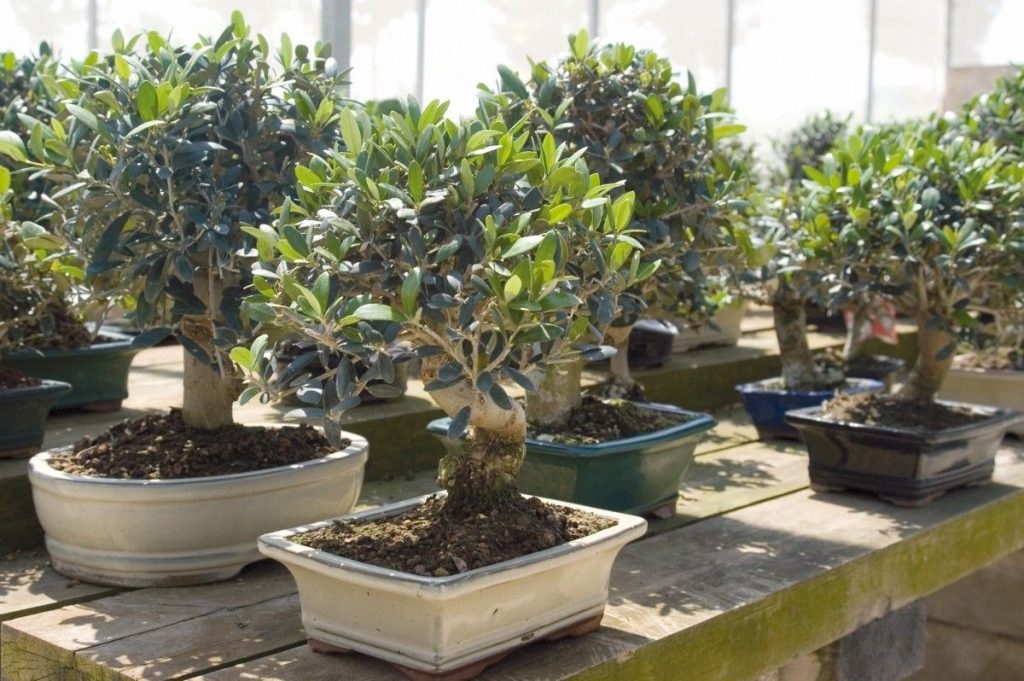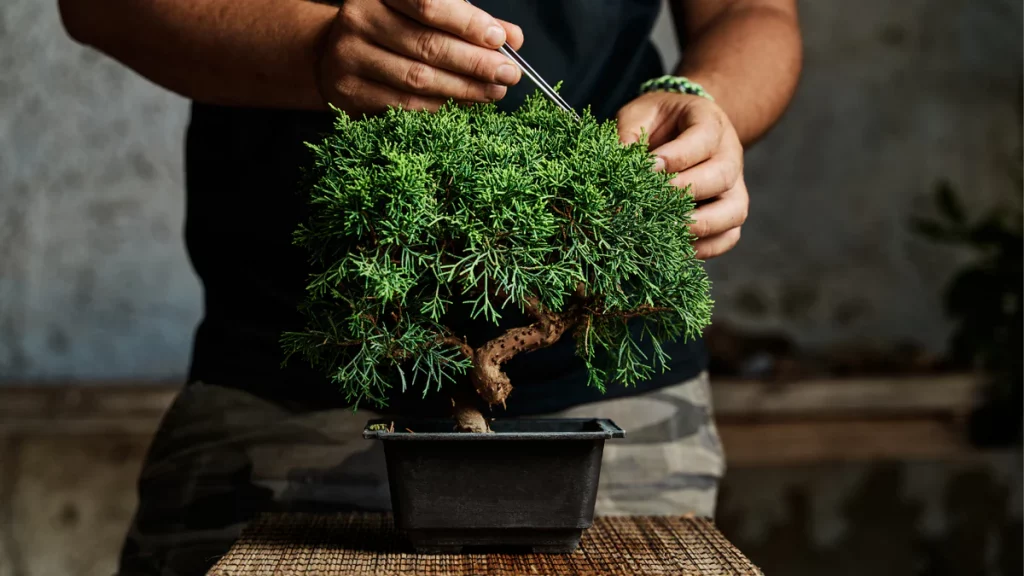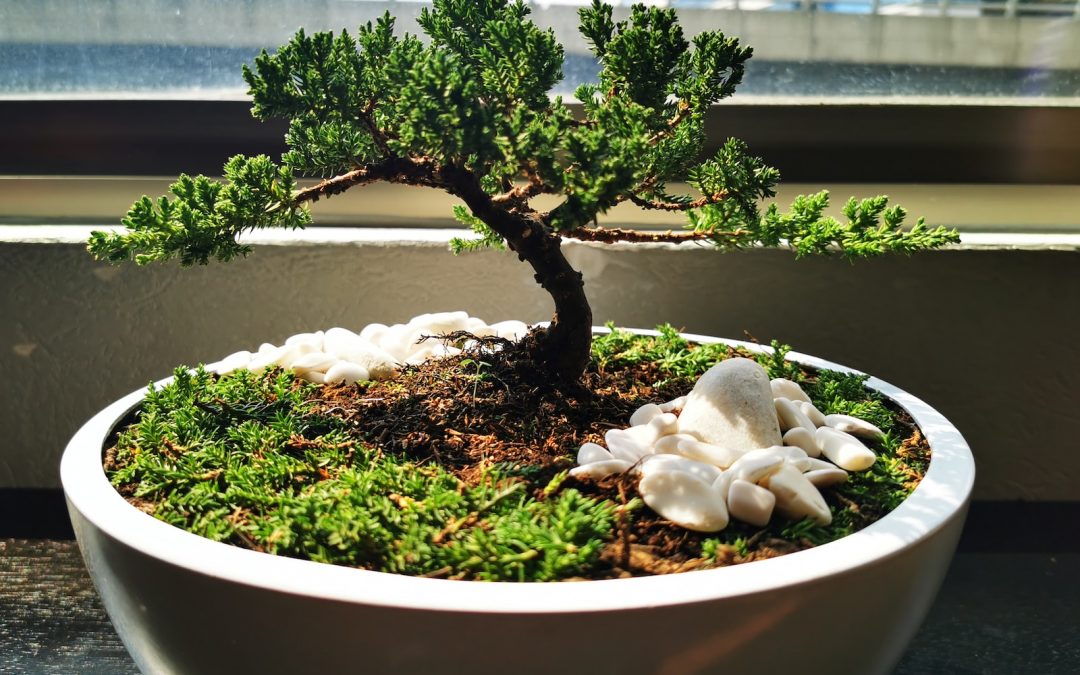What is a bonsai tree, really? It’s not a special species, but a normal tree grown in a small pot and trained to look like a mature, full-sized tree in miniature. Bonsai combines horticulture and art, and once you understand the basics, it becomes a relaxing, long-term hobby rather than something mysterious and fragile.
If you’re completely new and want a practical care routine to go with this overview, the Bonsai Tree Care guide is the perfect next step for watering, feeding and day-to-day maintenance.
Contents
- 0.1 What Is a Bonsai Tree?
- 0.2 A Short History of Bonsai
- 0.3 Common Species Used for Bonsai
- 0.4 How Bonsai Trees Stay Small
- 0.5 Indoor vs Outdoor Bonsai
- 0.6 Basic Care: What a Bonsai Tree Needs to Thrive
- 0.7 FAQs: Common Questions About What a Bonsai Tree Is
- 0.8 Final Thoughts on What a Bonsai Tree Is
- 0.9 Related Articles
- 1 Discover Mood-Boosting Indoor Plants
What Is a Bonsai Tree?
At its core, a bonsai tree is simply a tree or woody shrub grown in a pot and trained to stay small while still looking like an old, natural tree. The word “bonsai” comes from Japanese and roughly means “tree in a tray”.
Key ideas behind what a bonsai tree is:
It’s not a dwarf species – it’s a normal plant managed through pruning and root work.
The goal is to create the illusion of age and landscape in a small space.
Trunk thickness, branch structure and overall shape matter just as much as leaves.
Bonsai can be grown indoors or outdoors depending on species and climate.
So when you ask “what is a bonsai tree?”, the answer is less about the plant and more about the technique and long-term training that shape it.

A Short History of Bonsai
Understanding what a bonsai tree is also means understanding where the idea came from.
The early concept started in China, where potted landscape scenes and miniature trees were created as living art.
The practice was later refined in Japan, where bonsai developed its own styles, techniques and philosophy.
In recent decades, bonsai has spread worldwide, with artists and hobbyists working in many climates and using both traditional and local tree species.
Today, a bonsai tree can be anything from a tiny windowsill planting to a decades-old specimen exhibited at shows. The same basic principles apply whether you’re styling a cheap nursery plant or a carefully collected tree.
According to the Royal Horticultural Society’s guidance on bonsai, healthy bonsai start with choosing suitable species and then managing water, soil and pruning so the tree stays strong despite the small pot.
Common Species Used for Bonsai
Because bonsai is a technique, many different species can become bonsai trees. Some of the most popular choices include:
Chinese elm – Fast-growing, forgiving, and great for beginners.
Juniper – Classic “bonsai look” with flexible branches, ideal for outdoor styling.
Ficus – Popular for indoor bonsai, especially in warmer homes.
Maples – Beautiful seasonal colour and fine branching, often grown outdoors.
Pines and spruce – Traditional choices for rugged, windswept bonsai styles.
Smaller-leaved trees usually make better bonsai, because they stay in proportion with the miniature trunk and branches. When you’re first learning what a bonsai tree is and how it behaves, starting with a tough, beginner-friendly species like Chinese elm or ficus makes the learning curve much gentler.
How Bonsai Trees Stay Small
One of the most common questions after “what is a bonsai tree?” is “how does it stay so small?”. The answer is a combination of:
Pruning branches – To control height, shape and branching.
Root pruning – To keep roots compact and balanced when repotting.
Small pots – Less root space means slower, more controlled growth.
Careful watering and feeding – Enough to keep the tree healthy, not so much that it grows wild.
The goal isn’t to stunt or harm the tree, but to balance root and branch growth so the bonsai tree stays compact while still being vigorous. A well-cared-for bonsai can live for many decades, sometimes even longer than the same species in a garden.
A beginner bonsai starter kit with tools, wire and a shallow training pot can make it much easier to learn these techniques on your first tree.

Indoor vs Outdoor Bonsai
Another big part of understanding what a bonsai tree is comes down to where it should live.
Outdoor bonsai: Many species (juniper, pine, maple, spruce, some elms) are outdoor trees and need cold winters and fresh air to stay healthy. They should live outside for most or all of the year.
Indoor bonsai: Some tropical or subtropical species (many ficus varieties, some Chinese elms in mild homes) can be grown indoors in bright spots, often near a window.
In general:
If it’s a species that naturally grows outdoors in your climate, it usually wants to be an outdoor bonsai.
If it’s a tropical species that would not survive frost, it’s usually an indoor or semi-indoor bonsai that needs warm, bright conditions.
Always check the plant label or do a quick species search so you don’t accidentally treat an outdoor tree like a houseplant.
Basic Care: What a Bonsai Tree Needs to Thrive
Regardless of species, most bonsai trees share a few basic needs:
Light: Plenty of bright light, often full sun or bright indirect light depending on species.
Water: Frequent checking and deep watering when the soil surface starts to dry.
Soil: Free-draining bonsai soil that doesn’t stay soggy.
Feeding: Light, regular feeding in the growing season to support steady growth.
Pruning: Regular trimming to maintain shape and encourage fine branching.
A pair of sharp bonsai pruning shears makes day-to-day maintenance much easier than using general kitchen scissors, and helps you make clean cuts that heal quickly.
Once you get into a rhythm with checking soil moisture, watching how your bonsai responds to light, and pruning a little at a time, caring for a bonsai tree becomes far less intimidating.
FAQs: Common Questions About What a Bonsai Tree Is
1. Is a bonsai tree a special kind of tree?
No. A bonsai tree is a normal tree or shrub grown in a pot and trained through pruning and root work. It’s a technique, not a separate species.
2. How long can a bonsai tree live?
With good care, bonsai trees can live for many decades – some famous bonsai are over a hundred years old. The small pot doesn’t shorten their life if roots, water and nutrients are managed well.
3. Are bonsai trees cruel to the plant?
Not when done correctly. Healthy bonsai trees are pruned and repotted in ways that respect their natural growth. The idea is to balance the tree’s needs with the miniature shape, not to starve or damage it.
4. Do bonsai trees have to be kept indoors?
No. Many bonsai are actually outdoor trees that need seasonal changes and fresh air. Only certain species are suitable as true indoor bonsai.
5. Is bonsai hard for beginners?
Like any new hobby, there’s a learning curve, but you don’t need to be an expert to start. If you pick a forgiving species and learn a few basics about watering, light and pruning, bonsai can be very beginner-friendly.
Final Thoughts on What a Bonsai Tree Is
At its heart, a bonsai tree is a partnership between you and a plant. You provide the right pot, soil, light and care; the tree responds slowly, season by season, with new growth, thicker trunks and more character. Understanding what a bonsai tree is – a normal tree shaped over time, not a delicate ornament – makes the whole process feel more approachable.
If you’re curious, start simple: choose a beginner-friendly species, learn basic bonsai care, and practice gentle pruning. As your confidence grows, you can explore more styles, species and techniques. Over the years, watching a bonsai tree develop under your hands becomes one of the most rewarding parts of indoor and outdoor gardening.
Related Articles
KEEP YOUR HOME CALM WITH EASY PLANTS
Discover Mood-Boosting Indoor Plants
Once you’ve mastered low-maintenance indoor plants, why not choose varieties that also lift your mood? Our Mood-Boosting Indoor Plants guide highlights relaxing, feel-good plants that brighten your space without adding extra work.

